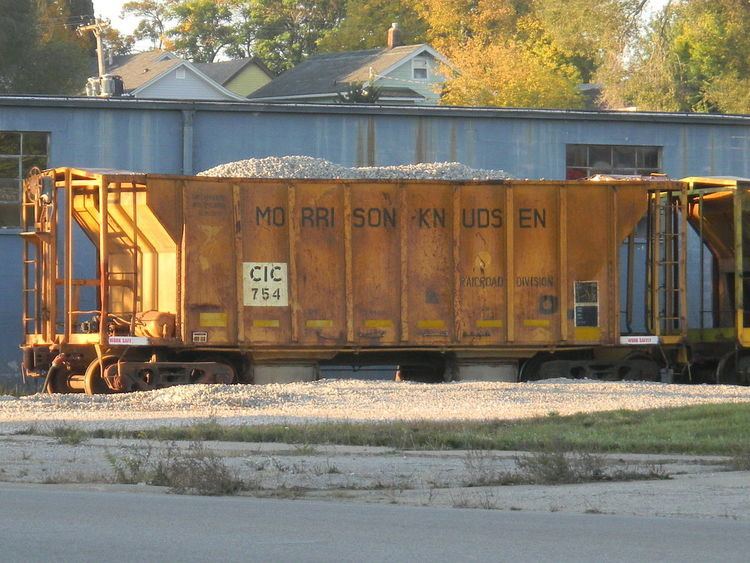 | ||
Morrison knudsen company
Morrison-Knudsen (MK) was a civil engineering and construction company, with headquarters in the Western United States city of Boise, Idaho.
Contents
- Morrison knudsen company
- Rare morrison knudsen rebuild
- Founders
- World War II
- Post war projects
- MK Rail
- Financial difficulty
- Additional growth
- References
MK designed and constructed major infrastructure throughout the world and was one of the consortium of firms that built Hoover Dam, the San Francisco–Oakland Bay Bridge, the Trans-Alaska Pipeline, and many other large projects of American infrastructure.
Rare morrison knudsen rebuild
Founders
MK's origins date to 1905, when Harry Morrison (1885–1971) met Morris Knudsen (1862–1943) while working on the construction of the New York Canal (Boise Project) in south-western Idaho. Morrison was a 20-year-old concrete superintendent for the Reclamation Service; Knudsen was a forty-something Nebraska farmer (and Danish immigrant) with a team of horses and a fresno scraper.
Their first venture together was in 1912, on a pump plant in nearby Grand View, for $14,000. They lost money but gained experience. In 1914 MK earned some revenue when they constructed the Three-Mile Falls Dam in Oregon. For several years the firm built irrigation canals, logging roads, and railways. They incorporated in 1923, the year gross revenues topped $1 million. MK reached a significant milestone with its joint venture in the construction of Hoover Dam in 1932-35.
World War II
During World War II, MK built airfields, storage depots, and bases throughout the Pacific and built ships along the American West Coast. Japanese forces captured 1,200 workers, including many MK employees, stationed on Midway and Wake Islands in late 1941. After the war MK expanded into a variety of foreign construction fields.
Post-war projects
MK won contracts for many domestic and foreign Cold War projects. It built the locks on the St. Lawrence Seaway, the Distant Early Warning Line system, Minuteman missile silos, NASA’s Kennedy Space Center, and over 100 major dams. Morrison was featured on the cover of Time magazine on May 3, 1954. The article claimed Morrison was "the man who has done more than anyone else to change the face of the earth." From 1962 to 1972 MK worked in a joint venture to serve the United States military as civilian contractors for infrastructure in the Vietnam War. The group was called RMK-BRJ and included Raymond International, Brown & Root, and JA Jones Construction Company.
MK Rail
MK was also involved in the construction of rail projects such as the Bay Area Rapid Transit (BART) extension (MK also built 80 C2 cars for BART in 1994) and the single track Apoera-Bakhuys Railway in Suriname (1976–1977).
In the 1950s it was involved in the construction of the Rimutaka Tunnel in New Zealand, the longest rail tunnel in the southern hemisphere. In the late 1960s and early 1970s, MK was involved in the construction of the Hamersley & Robe River and Mount Newman railways in the Pilbara region of Western Australia.
MK built the Caltrans California Cars (1994–96) as well as other rail passenger cars and light rail. It also built locomotives, originally under its own name and later under subsidiary MK Rail from 1994–1996, such as the MK5000C and the F40PHM-2C. MK also rebuilt locomotives, including the four Delaware & Hudson ALCO PAs. Its Australian operation, based in Whyalla, South Australia, rebuilt 17 CL and eight AL class locomotives for Australian National and six DE class locomotives for BHP in the 1990s.
MK was also one of the largest passenger railcar builders, located at the former Erie Railroad shop in Hornell, New York, overhauling and rebuilding many New York City Transit subway cars between 1984 and 1992 including R26/R28s, R29s, R32s (Phase I & II), some R36 World's Fair cars (pilot program), R42s, R44s, and R46s. It also overhauled NJ Transit's Arrow I series cars, converting from electric MUs to push-pull coaches, and SEPTA's Silverliner II and III series electric commuter cars in the late 1980s.
The CTA 3200 series and Metro-North M-6 "Cosmopolitan" cars were built by MK in 1992-1994.
Financial difficulty
By the 1990s, Morrison-Knudsen had been led into some risky non-core areas by Boise native William Agee, who became CEO in 1988 and was ousted by the board of directors in February 1995. MK had announced a loss of $310 million for fiscal year 1994, and a leak of an intended Agee resignation drew broad media attention which resulted in Agee resigning earlier than originally planned. The company had been in financial difficulty for several years and declared bankruptcy that same year. It was purchased by Washington Group in 1996 for $380 million. The locomotive manufacturing operations of MK were divested and are now part of Wabtec. The Hornell (NY) rail shops are now an Alstom facility.
Additional growth
For several years after the 1996 merger, the company continued as Morrison-Knudsen. Growth by acquisition brought it into the top tier (by size) of American construction firms. In 1999, MK acquired the government-services operations of Westinghouse Electric Company, becoming a science and technology services leader. In 2000, the company expanded its market leadership by acquiring Raytheon Engineers & Constructors, which owned Birmingham, Alabama-based engineering giant Rust International, to produce one of the largest companies in the industry. Following the acquisition, the MK's corporate name changed to Washington Group International in July 2000. Issues with the Raytheon acquisition caused WGI to declare bankruptcy in 2001 - virtually eliminating all shareholder value, but later successfully exited it.
